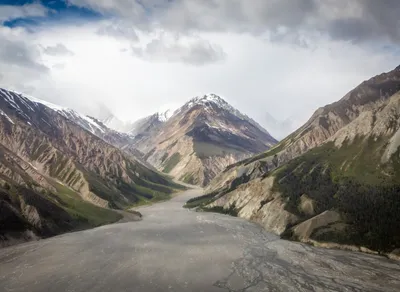For over long years, we have diligently conducted independent research and product testing. When you make a purchase through our links, we may earn a commission.
The Essential Guide to Missing Hiker Situations in Trekking
Created: 6 minutes ago

7 min Read
When embarking on a challenging trekking adventure, it's essential to prioritize safety and be prepared for any unforeseen circumstances that may arise. Unfortunately, every year, there are cases of hikers going missing in remote locations. This article aims to provide a comprehensive guide on hiking preparedness, emergency protocols, search and rescue techniques, wilderness survival skills, and safety tips. We will cover everything from hiking for beginners to essential gear and equipment, as well as navigation and first aid in the wilderness.
Importance of Hiking for Beginners
The Joy of Exploring Nature on Foot
Hiking is a wonderful outdoor activity that allows individuals to explore nature while challenging themselves physically and mentally. It offers an escape from the urban chaos and an opportunity to reconnect with the natural world. However, for beginners, it's crucial to start with shorter, well-marked trails and gradually increase the difficulty level.
Building Physical Fitness and Stamina
Hiking is an excellent way to improve one's physical fitness and stamina. Regular hiking strengthens muscles, increases cardiovascular endurance, and enhances overall body flexibility. By gradually increasing the distance and difficulty of the hikes, beginners can train their bodies to handle more challenging treks.
Mental Health Benefits
In addition to the physical benefits, hiking also has a positive impact on mental well-being. Spending time in nature helps reduce stress and anxiety, improves mood, and promotes a sense of calm and tranquility. It allows individuals to disconnect from technology and experience the beauty of the natural world.
Emergency Preparedness for Hikers
Importance of Emergency Planning
When venturing into the wilderness, it's crucial to have a well-thought-out emergency plan in place. This plan should include important contact information, communication devices, emergency signaling techniques, and knowledge of local search and rescue procedures. It's essential to inform someone about your itinerary and expected return date before setting out on a hike.
Essential Emergency Supplies
Carrying essential emergency supplies is vital to ensure preparedness in case of unforeseen situations. Some of the key items to include in your hiking backpack are:
- [ ] First Aid Kit: An essential item that should always be carried while hiking. It should contain bandages, antiseptic wipes, pain relievers, tweezers, and any prescription medications.
- [ ] Map and Compass: Even if you are relying on GPS navigation, it's essential to have a physical map and compass as a backup.
- [ ] Flashlight and Extra Batteries: A reliable source of light is crucial in emergency situations or when hiking at night.
- [ ] Emergency Shelter: A lightweight emergency shelter, such as a bivy sack or emergency blanket, can provide temporary protection from harsh weather conditions.
- [ ] Whistle: A loud whistle is an important signaling device that can attract attention and help rescuers locate you.
- [ ] Water and Food: Always carry extra water and high-energy snacks in case of extended stays in the wilderness.
- [ ] Fire-starting Tools: Carrying waterproof matches or a Bic lighter can be a lifesaver in emergency situations, providing warmth and a means to cook food.
Navigation and Trail Safety
Mastering the Art of Navigation
Navigating through unfamiliar terrain is a crucial skill for every hiker. While technological advancements have made GPS devices readily available, it's essential to also learn traditional navigation techniques using a map and compass. Understanding topographic maps, contour lines, and using compass bearings can help hikers find their way in case of a GPS failure.
Staying Safe on the Trails
To ensure a safe hiking experience, it's important to follow some basic trail safety guidelines:
- [ ] Stay on Designated Trails: Straying off the marked trail increases the risk of getting lost or encountering hazardous conditions.
- [ ] Be Aware of Weather Conditions: Check the weather forecast before heading out on a hike. Change in weather can significantly affect trail conditions and increase the risk of accidents.
- [ ] Dress Appropriately: Dress in layers to accommodate changing weather conditions. Always wear proper footwear, such as hiking boots, to ensure stability and protect your feet.
- [ ] Take Regular Breaks: Resting and hydrating at regular intervals helps prevent fatigue and keeps hikers alert and focused.
- [ ] Leave No Trace: Practice Leave No Trace principles to minimize your impact on the environment. This includes packing out all trash and minimizing campfire impact.
Search and Rescue Techniques
Immediate Actions
If you find yourself in a situation where you can't find your way back or encounter an emergency, it's crucial to remain calm and take immediate actions:
- [ ] Stop and Assess: Pause for a moment to assess the situation. Determine if you are in immediate danger or need to move to a safer location.
- [ ] Use Navigation Tools: If you have a GPS, use it to try and pinpoint your location. If not, refer to your map and compass to orient yourself.
- [ ] Signal for Help: If you are in a visible location, use your whistle or any other signaling device to attract attention. Create a distress signal using rocks or branches that can be seen from afar.
Wilderness Survival Skills
Survival skills are essential for every hiker, as they can mean the difference between life and death in a survival situation. Here are some key wilderness survival techniques to keep in mind:
Shelter Building
In case of an emergency or unexpected overnight stay, knowing how to build a shelter using natural materials can provide protection from the elements. Look for natural features like caves, rock overhangs, or fallen tree branches to create a makeshift shelter. If these options are not available, learn how to construct a basic debris shelter using sticks, leaves, and branches.
Water Procurement and Purification
Water is crucial for survival, and finding a safe water source is a top priority. Learn how to identify potential water sources such as streams, rivers, or lakes. However, it's important to remember that water from natural sources might be contaminated. Boiling water, using water purification tablets, or carrying a portable water filter can help render water safe to drink.
Fire-Making Skills
Fire provides warmth, light, and a means to cook food. Every hiker should know how to start a fire using basic fire-making techniques. Carry fire-starting tools such as waterproof matches, lighters, or a fire starter kit. Learn how to gather tinder, kindling, and fuelwood, and practice the skill of fire starting in various weather conditions.
Survival Gear Checklist
Having the right gear and equipment can significantly increase your chances of survival in a missing hiker situation. Here is a survival gear checklist to ensure you have everything you need:
| Essential Gear | Description |
|---|---|
| First Aid Kit | Includes bandages, antiseptic wipes, pain relievers, tweezers, etc. |
| Map and Compass | For navigation purposes and as a backup to GPS devices. |
| Flashlight and Extra Batteries | Provides light and can be used for signaling. |
| Emergency Shelter | Lightweight emergency shelter such as a bivy sack or emergency blanket. |
| Whistle | A loud signaling device to attract attention. |
| Water and Food | Carry extra water and high-energy snacks. |
| Fire-starting Tools | Waterproof matches, a Bic lighter, or fire starter kit. |
| Multi-tool or Knife | Can be used for various purposes like cutting rope or opening cans. |
| Communication Device | Carry a fully charged cell phone or a satellite communication device. |
| Personal Locator Beacon (PLB) | A distress signal device that can be used to alert authorities in an emergency. |
Remember to familiarize yourself with how to use each item in your survival gear checklist to ensure their effectiveness in a real-life situation.
Wilderness First Aid
Importance of Wilderness First Aid
In a missing hiker situation, injuries, or illnesses can occur, and being prepared to provide first aid in a wilderness setting is critical. Wilderness first aid focuses on managing emergency situations when professional medical help may be hours or even days away.
Essential First Aid Skills
Here are some essential wilderness first aid skills to learn:
- [ ] Assessing Injuries: Learn how to assess and stabilize common injuries such as cuts, burns, fractures, and sprains.
- [ ] CPR and AED: Know how to perform cardiopulmonary resuscitation (CPR) and use an automated external defibrillator (AED) if available.
- [ ] Treating Hypothermia and Heat Exhaustion: Understand how to recognize and treat common environmental emergencies such as hypothermia and heat exhaustion.
- [ ] Splinting: Learn different techniques for splinting bone fractures to immobilize the affected limb and prevent further injury.
- [ ] Dealing with Allergic Reactions: Know how to recognize and treat allergic reactions, including anaphylaxis, using an epinephrine auto-injector if available.
Conclusion
In conclusion, trekking and hiking can be incredible experiences that allow us to connect with nature and push our limits. However, it's essential to prioritize safety and be prepared for any emergency situation that may arise. By following the guidelines outlined in this article, including hiking for beginners, emergency preparedness, search and rescue techniques, wilderness survival skills, outdoor safety tips, and essential gear checklist, hikers can significantly reduce the risk associated with missing hiker situations. Remember, proper planning, education, and experience are the keys to safe and enjoyable trekking adventures. Stay safe, enjoy nature responsibly, and happy hiking!
Frequently Asked Questions (FAQs)
What should I do if I become lost while hiking?
If you find yourself lost while hiking, the first step is to remain calm. Stay in one place and try to retrace your steps. If you can't find your way back, use any navigational tools you have, such as a compass or GPS device, to determine your location. If all else fails, signal for help by making noise, creating a visible marker, or using any emergency communication devices you may have.
When should I contact authorities about a missing hiker?
You should contact authorities immediately if a hiker in your group goes missing. Time is crucial in search and rescue operations, so don't wait too long before reporting a missing person. Provide the authorities with all the relevant information, such as the hiker's last known location, physical appearance, and any unique identifiers or belongings they had with them.
What can I do to prevent becoming a missing hiker?
To avoid becoming a missing hiker, it's important to be prepared and take necessary precautions. Always plan your hike in advance, inform someone of your intended route, and stick to established trails. Carry essential supplies, such as maps, first aid kits, extra food and water, and appropriate clothing. Familiarize yourself with basic navigation techniques, and be aware of the weather conditions and terrain of the area you'll be trekking in.
How long do search and rescue operations usually last?
The duration of search and rescue operations can vary depending on several factors, such as the size of the search area, weather conditions, available resources, and the nature of the terrain. Some operations can be resolved within a few hours or days, while others may last for weeks or even longer. It's essential to initiate search efforts as soon as possible to maximize the chances of a successful outcome.
What should I do if I find a missing hiker?
If you come across a missing hiker while trekking, it's important to approach them cautiously and offer assistance. Ensure their safety and provide any necessary first aid if needed. If there's no immediate danger, encourage them to stay put until rescue personnel can reach them. If necessary, provide them with food, water, or any other essentials you may have. Then, promptly report the discovery to the relevant authorities.
